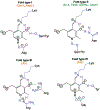Reactive Enamines and Imines In Vivo: Lessons from the RidA Paradigm
- PMID: 31103411
- PMCID: PMC6760865
- DOI: 10.1016/j.tibs.2019.04.011
Reactive Enamines and Imines In Vivo: Lessons from the RidA Paradigm
Abstract
Metabolic networks are webs of integrated reactions organized to maximize growth and replication while minimizing the detrimental impact that reactive metabolites can have on fitness. Enamines and imines, such as 2-aminoacrylate (2AA), are reactive metabolites produced as short-lived intermediates in a number of enzymatic processes. Left unchecked, the inherent reactivity of enamines and imines may perturb the metabolic network. Genetic and biochemical studies have outlined a role for the broadly conserved reactive intermediate deaminase (Rid) (YjgF/YER057c/UK114) protein family, in particular RidA, in catalyzing the hydrolysis of enamines and imines to their ketone product. Herein, we discuss new findings regarding the biological significance of enamine and imine production and outline the importance of RidA in controlling the accumulation of reactive metabolites.
Keywords: 2-aminoacrylate stress; RidA; enamine/imine metabolism; reactive metabolite.
Copyright © 2019 Elsevier Ltd. All rights reserved.
Figures




References
-
- de Lorenzo V et al. (2015) Chemical reactivity drives spatiotemporal organisation of bacterial metabolism. FEMS Microbiol. Rev 39 (1), 96–119. - PubMed
-
- Albert R et al. (2000) Error and attack tolerance of complex networks. Nature 406 (6794), 378–382. - PubMed
-
- de Crecy-Lagard V et al. (2018) Newly-discovered enzymes that function in metabolite damage-control. Curr. Opin. Chem. Biol 47, 101–108. - PubMed
Publication types
MeSH terms
Substances
Grants and funding
LinkOut - more resources
Full Text Sources
Molecular Biology Databases
Miscellaneous

